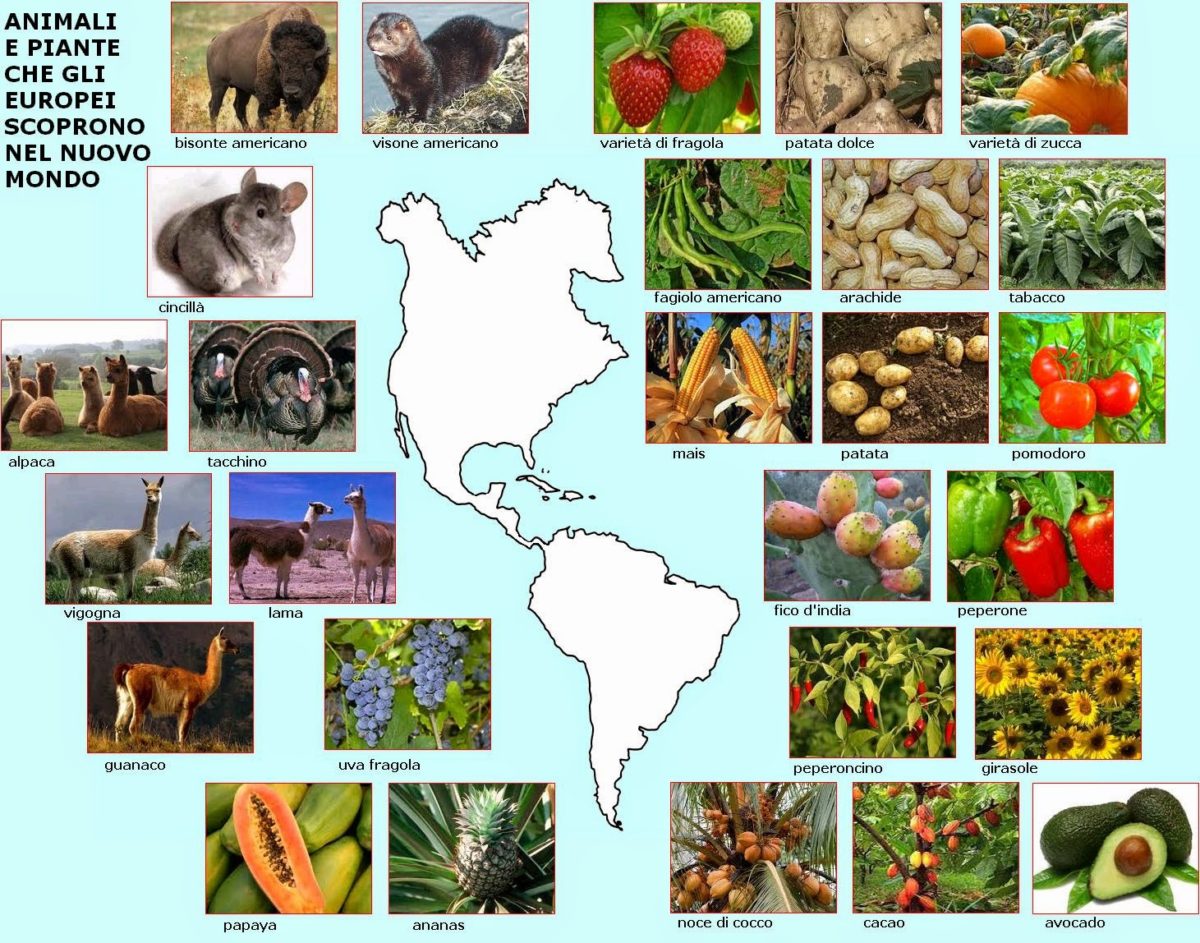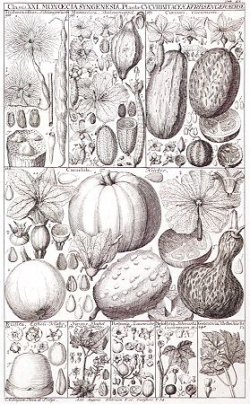This section of the project Memoria Presente: The Common Spanish Legacy in Italian and Latin American Cultures focuses on the plants that the Spaniards found in the Americas as part of their territorial expansion and that they brought back to Europe, both in Spain and the other areas annexed to the Spanish Empire, such as specific Italian regions, including Sicily. While some of them remain identified as “foreign” and “exotic” (avocado, for example), others have ironically become such an integrated element of the local cuisine to the point of being perceived as authentically local and even being protected by special official labels (tomato, for instance). The cultural encounter involved also animals, which this section does not cover (the turkey is the most obvious example of the expansion of the fauna in Europe, after the exploration and invasion of the Americas).
Interestingly, the encounter worked in two directions along the transnational routes of commerce: it became known as “Columbian Exchange,” and it involved the relocation of plants and animals from Europe to the Americas as well. The devastating consequences of this encounter (death by new illnesses and war) have being addressed by a vast body of literature. This project focuses on the legacies of this encounter, and how it is interwoven in the fabric of daily lives both in Europe and in Latin America today.
Note: This section is preparatory to the section on foods, cuisine and gastronomy.

Among the plants brought to Italy from the Americas, these are the most relevant ones for the “Memoria presente” project which emphasizes the connections to Italy:
- POMODORO/TOMATE/TOMATO (from the Nahuatl language spoken by the Aztecs “tomatl o Jitomate”)The tomato arrives to Italy via the ports of Naples and Genoa, and is used as an ornamental plant at first (the “pomo d’oro” – golden fruit). In the mid-1500s it starts being used for cooking and ironically becomes an essential element in Italian cooking over time (pizza, pasta sauces, lasagne, etc.)
- PEPERONCINO/CHILI/CHILI PEPPER (called ajì in the Caribbean area)Dubbed “the fire vegetable,” the chili pepper was identified in the late 1400s by Columbus as a basic condiment of all local dishes. In Italy it was introduced in the 1600s with the name of “coral horn” (corno di corallo) and then “peperoncino.” It is a key ingredient in the quintessentially simple Italian pasta dish “aglio, olio e peperoncino” as well as in the other common pasta dish, “amatriciana.”
- PEPERONE/PIMENTÓN/BELL PEPPER (capsicum annuum, same family of the tomato)The bell pepper is a common plant in vegetable gardens, it is cultivated extensively in all regions, and it is a common ingredient in many recipes from pasta condiments to side dishes.
- MAIS o GRANOTURCO/MAÌS/CORNCorn was common as early as 1000 years before Christ, including among Indian communities now part of the US (Hopi Indians) for the preparation of a masa used for tortillas. Since the 1600s, it replaces millet in European agriculture, and is used as animal food as well as for several purposes. In Norther Italy, it becomes the main cereal, used for the preparation of polenta, a crucial element of the traditional diet as a substitute for bread.
- PATATA/PAPA/POTATO (same family of the tomato)Rich in sugar and starch, the potato was introduced in Tuscany in the early 1600s but never became a major agricultural product in Italy, despite its wide use in the country’s gastronomy. One example for all, a basic dish like “frittata di patate,” which is interestingly reminiscent of the Spanish tortilla.
- CACAO/CACAO/CACAO (in Nahuatl Xoco-atl (“bitter water”)Considered to be a sacred plant introduced by the god Quetzalcoatl, cocoa was the base for a very common cold drink among the Aztec aristocrats (mixed with chili pepper, vanilla and honey). The drink, along with the cocoa beans, was introduced in Europe in the early 1600s and became soon popular. The plant can only be cultivated in tropical climates, but it’s imported into Italy for manufacturing of food products that over time have become traditionally Italian: “gianduiotto,” “cremino” and chocolate creams, such as the very popular Nutella. An interesting example of how the Columbian Exchange dynamics have remained in place in more visible ways is the chocolate bar produced in Modica according to the Aztec tradition (see dedicated webpage).
- VANIGLIA/VAINILLA/VANILLA (from the Spanish word “vainas”, pod). Produced for centuries only in Mexico, it was cultivated in Europe only after the introduction of artificial pollination. It has become a key ingredient in the Italian patisserie.
- FICO D’INDIA/TUNA DEL NOPAL//PRICKLY PEAR A cactus originally from Mexico and common in Central America, it was introduced very early in Southern Europe after Columbus’ return from the Caribbean area. It is a very resistant and aggressive wild plant that has become a classic presence in the landscape of Italian regions such as Sicily, Calabria and Sardegna. While in Mexico, the plant’s thick leaves are also eaten (nopal) in salads, this is not the case in Southern Italy where the plant is cultivated for the fruit, characterized by a colorful (red, yellow or green) sweet pulp mixed with hard seeds.
- ZUCCA/CALABAZA/PUMPKIN (pumpkin). While the pumpkin was already known in Italy, the post-1492 era brought a new species. In Sicily, the arrival of it with the Spaniards also prompted the creation of an amusing proverb over time: “A cucuzza vinni cauda d’a Spagna” (the pumpkin has come hot from Spain) aimed at teasing the hot- but empty-headed Spanish conquerors, or by extension the Spanish aristocrats… (source: Mediterranean Vegetables: A Cook’s ABC of Vegetables and Their Preparation in Spain, France, Italy, Greece, Turkey, the Middle East, and North Africa, … than 200 Authentic Recipes for the Home Cook by Clifford A. Wright. Boston: Harvard Common Press, 2001, p. 314).
- TABACCO/TABACO/TOBACCO (called “tobago” in Haiti).It was both smoked and used as a medicinal plant. Once introduced in Europe, it also had a double purpose, but soon developed into a plant for personal enjoyment, and was made into state monopoly given its popularity.
- FRUTTI TROPICALI: a. AVOCADO (in Nahuatl ahuacatl and in Spanish Aguacate).It was introduced in the mid-1500s in Rome but did not grow. Only in the 20th-century does the cultivation start in Italy. b. ANANAS//PINEAPPLE/PIÑA
RESOURCES (see Bibliography for more information)
Encyclopedia Britannica entry about “Columbian Exchange”
Article about plants brought from the Americas (Accademia Properziana del Subasio)
“The Columbian Exchange: A History of Disease, Food, and Ideas,” an article by Nathan Nunn and Nancy Qian. Journal of Economic Perspectives 24:2 (Spring 2010). 163-188.
Crosby, Alfred W., Jr, The Columbian Exchange: Biological and Cultural Consequences of 1492 – 30th Anniversary Edition, Greenwood Publishing Group, 1972.
TEACHING ACTIVITIES FOR ITALIAN FOR SPANISH SPEAKERS CLASSES (while the prompts are in English, the assignment are submitted in Italian)
- Beginning level:
- Vocabulary matching exercise: Ask students to match images and names of plants in Italian based on two provided lists.
- Phonetics/Orthography: Record your voice while reading the Italian names of the plants. After providing the actual pronunciation in Italian, compare the equivalent sounds in Spanish. Also, compare the words in the two languages and identify some patterns (ll=gli, as in maravilloso/meraviglioso).
For teachers: Emphasize the closeness of the languages to the point of having perfect homophones (cacao), slightly different pronunciations in terms of accents (mais/maìs), or slightly different sound/writing as in tabacco/tobacco. - Grammar exercise: Building on the previous activity, complete a fill in exercise where you choose the correct article for all the plants included in a paragraph. Then turn the paragraph from the singular to the plural form.
- Creative activity: Imagine planning a vegetable garden with five of these plants. Develop a sketch with the plants’ names on it, and include images in order to render the visual outcome. Consider the size of the plants and the general dimensions of the space they need to grow.
- Intermediate level:
- Vocabulary matching exercise – Match images and names of plants in Italian based on two provided lists. For the five extra images without the name and look up the name online. These images may include those of plants that were brought from Europe to the Americas.
For teacher: examples may include: peanut, pineapple, etc. for the Europe-Americas route and onion, carrot, and apple for the reversed route. - Creative writing activity: Imagine planning a vegetable garden with eight of these plants. Develop a sketch with the plants’ names on it and include images in order to render the visual outcome. Consider the size of the plants and the general dimensions of the space they need in order to grow. Add a couple of sentence for each choice to describe the plant physically and to explain why it was included (250 words roughly: use present and passato prossimo, pay attention to agreement).
- Vocabulary matching exercise – Match images and names of plants in Italian based on two provided lists. For the five extra images without the name and look up the name online. These images may include those of plants that were brought from Europe to the Americas.
- Advanced level:
- Research project: Look into the list of plants that the Spaniards brought to the Americas. Develop a document similar to the one above with names and descriptions.
- Creative and technical writing activity: Imagine planning a vegetable garden with ten of these plants. Develop a sketch with the plants’ names on it and include images in order to render the visual outcome. Produce a 2-page narrative document including the description of the plant, the general costs involved in planting them, and the general expected time for the garden to be productive. Add a section about the reasons for their choices and their expectations in terms of the visual and productive outcome (500 words minimum: use of past, present and future tense as well as subjunctive after verbs such as sperare, augurarsi, vorrei che; use of adverbs in the sentence transitions).
***
This page was created as part of an NEH (National Endowment for the Humanities) grant, and with the logistical support of Montclair State University. For information about the NEH Faculty Award linked to the Memoria Presente project, see link.

